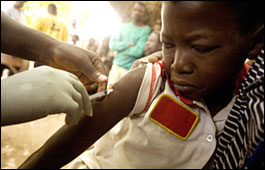
TAIPEI, Taiwan:- While Mexico ponders a statue of its first swine flu survivor, millions in Africa might contract yellow fever if funds for vaccines are not secured before stockpiles run out in 2010.
The World Health Organisation (WHO) says that there are 206 000 cases of yellow and 52 000 deaths worldwide every year.
However, there is no funding to cover yellow fever vaccination campaigns once the stockpile is depleted in 2010.
The International Coordinating Group (ICG) on Yellow Fever Vaccine Provision sounded the warning in a press release this week.
“We have to finish the job we started or the good work that has been done will be lost,” said Dr Edward Hoekstra, UNICEF Senior Health Specialist.
“If the stockpile of yellow fever vaccine is allowed to run out, countries that have not yet been reached by immunization campaigns will be unfairly burdened with the disease,” he said.
More than 95% of the vulnerable populations targeted in Togo, Mali, Senegal, Burkina Faso and Cameroon are now protected from contracting yellow fever.
Burkina Faso vaccinated 7.6 million people in 33 districts and Cameroon completed a vaccination campaign for 7.5 million people in 62 districts.
They were vaccinated during recent campaigns with funding from the International Finance Facility for Immunization (IFFIm).
There have been no outbreaks in those countries since the vaccination campaigns were completed.
150 million still at risk
However, the populations of seven other African countries will continue to be at risk if vaccination supplies are not replenished. The countries are Benin, Sierra Leone, Nigeria, Liberia, Guinea, Ghana, and Cote d’Ivoire.
Dr. Hoekstra said there was a need to further expand the programme to protect the remaining 150 million children and adults still at risk in these countries.
He said that close cooperation among all partners has been effective in supporting national governments to successfully implement the vaccination campaigns.
“If we do not sustain this programme, yellow fever outbreaks will continue to affect populations who can least afford it,” said Dr Fenella Avokey of the WHO African Regional Office.
“This is something we had hoped to resolve by 2015.”
Dr. William Perea is the World Health Organisation (WHO) coordinator for the Epidemic Readiness and Intervention.
“As we look beyond 2009, we already see serious funding constraints. Although yellow fever vaccine production has tripled since 2001, the roll-out of the programme is limited by insufficient supply of vaccine for 2009,” he said.
He said the yellow fever initiative was feeling the effects of the global financial crisis.
Yellow fever is caused by a virus transmitted by mosquitoes. The disease is endemic in forest areas and people are at greatest risk at the end of the rainy season.
Governor Fidel Herrera of the Mexican state of Veracruz has proposed a statue of Édgar Hernández, 5, the first person known to have contracted the swine flu virus.
The New York Times says Herrera said the monument could help attract tourists to La Gloria, a poor village where hundreds of residents came down with mysterious flulike symptoms beginning in late winter.





